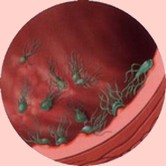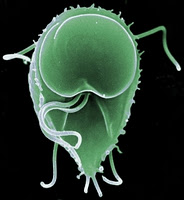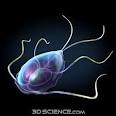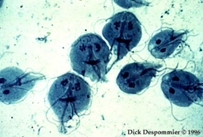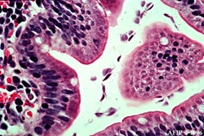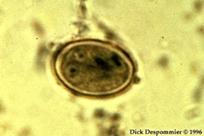GIARDIA
Giardia lamblia (synonymous with Giardia intestinalis, Lamblia intestinalis and Giardia duodenalis) is a flagellated protozoan parasite that colonizes and reproduces in the small intestine, causing giardiasis. The giardia parasite attaches to the epithelium by a ventral adhesive disc, and reproduces via binary fission.
1. Giardiasis does not spread via the bloodstream, nor does it spread to other parts of the gastro-intestinal tract, but remains confined to the lumen of the small intestine.
2. Giardia trophozoites absorb their nutrients from the lumen of the small intestine, and are anaerobes. If the organism is split and stained, it has a very characteristic pattern that resembles a familiar "smiley face" symbol. Chief pathways of human infection include ingestion of untreated sewage, a phenomenon particularly common in many developing countries;
3. contamination of natural waters also occurs in watersheds where intensive grazing occurs.
Hosts:
Giardia infects humans, but is also one of the most common parasites infecting cats, dogs and birds. Mammalian hosts also include cows, beavers, deer, and sheep.
Transmission:
Giardia infection can occur through ingestion of dormant microbial cysts in contaminated water, food, or by the faecal-oral route (through poor hygiene practices). The cyst can survive for weeks to months in cold water,
and therefore can be present in contaminated wells and water systems, especially stagnant water sources such as naturally occurring ponds, storm water storage systems, and even clean-looking mountain streams. They may also occur in city reservoirs and persist after water treatment, as the cysts are resistant to conventional water treatment methods such as chlorination and ozonolysis.
Zoonotic transmission is also possible, and therefore Giardia infection is a concern for people camping in the wilderness or swimming in contaminated streams or lakes, especially the artificial lakes formed by beaver dams (hence the popular name for giardiasis, "Beaver Fever").
In addition to waterborne sources, fecal-oral transmission can also occur, for example in day care centers, where children may have poor hygiene practices. Those who work with children are also at risk of being infected, as are family members of infected individuals. Not all Giardia infections are symptomatic, and many people can unknowingly serve as carriers of the parasite.
Symptoms of infection include (in order of frequency):
- diarrhea,
- malaise,
- excessive gas (often flatulence or a foul or sulphuric-tasting belch, which has been known to be so nauseating in taste that it can cause the infected person to vomit),
- steatorrhoea (pale, foul smelling, greasy stools),
- epigastric pain,
- bloating,
- nausea,
- diminished interest in food,
- possible (but rare) vomiting which is often violent, and weight loss.
Pus, mucus and blood are occasionally present in the stool. It usually causes "explosive diarrhea" and while unpleasant, is not fatal. In healthy individuals, the condition is usually self-limiting, although the infection can be prolonged in patients who are immunocompromised, or who have decreased gastric acid secretion.
People with recurring Giardia infections, particularly those with a lack of the Immunoglobulin A antibody, may develop chronic disease.
Lactase deficiency may develop in an infection with Giardia, however this usually does not persist for more than a few weeks, and a full recovery is the norm.
Some studies have shown that giardiasis should be considered as a cause of vitamin B12 deficiency, this a result of the problems caused within the intestinal absorption system.
"DETA-AP" AFFECTING MICROBES, HELMINTES, PROTOZOAS AND BACTERIAS:
I WISH YOU SUCCESSFUL TREATMENT AND GOOD HEALTH!

